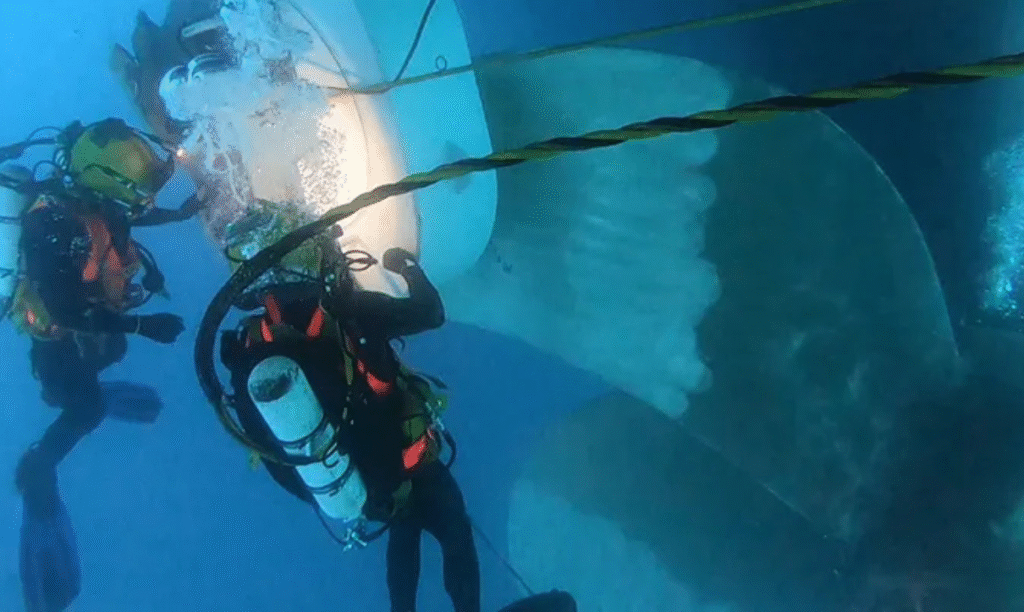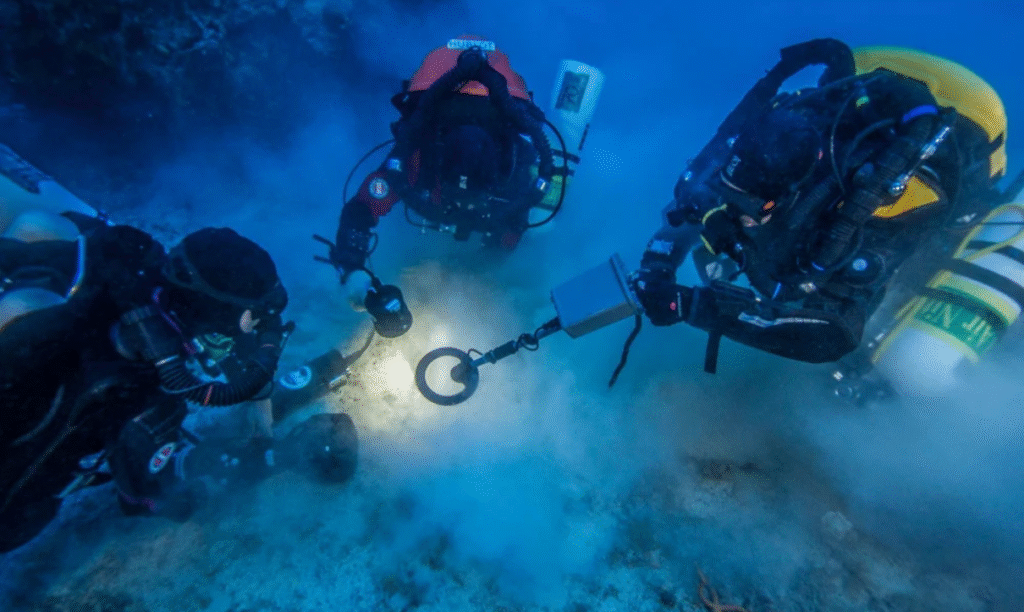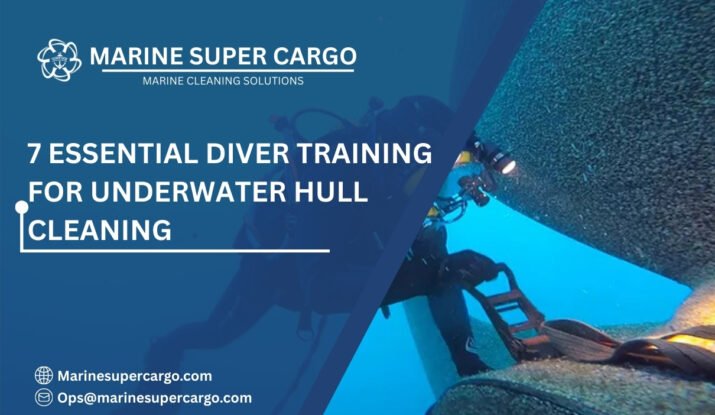Imagine your ship as a living giant. Below the waterline, algae, barnacles, and marine growth cling to its skin, slowing it down and burning more fuel. Now imagine sending divers beneath the waves—armed not with swords but with brushes, scrapers, and advanced tools—to restore it to its original speed and efficiency.
That’s where diver training for underwater hull cleaning steps in: a discipline that blends technical mastery, safety expertise, and environmental responsibility. If you’re a ship owner, operator, or manager, you already know that effective hull cleaning saves money and meets international compliance standards.
But few realize that the real foundation of successful hull cleaning lies in how well divers are trained. This guide explores diver training for underwater hull cleaning, why it matters, what it involves, and how it shapes the shipping industry’s future.
Why Diver Training for Underwater Hull Cleaning Matters
Diving beneath a ship’s hull isn’t just a glamorous deep-sea adventure. It’s a complex, high-risk, and highly regulated task. Poor training can lead to:
- Accidents or fatalities due to underwater hazards.
- Damaged hulls from improper cleaning techniques.
- Regulatory non-compliance, causing fines and detentions.
But with solid diver training for underwater hull cleaning, operations benefit from:
- Enhanced crew safety.
- Optimal hull performance and fuel savings.
- Compliance with international standards like IMO and MARPOL.
Think of divers as surgeons and the ship’s hull as a patient. Would you let an untrained surgeon perform surgery? Training is the scalpel of precision.

Core Skills in Diver Training
Professional diver training for underwater hull cleaning combines physical, technical, and analytical skills. Let’s break it down:
- Underwater Navigation – Divers learn to orient themselves around massive hull surfaces safely.
- Tool Handling – Training covers handling brushes, hydraulic scrapers, suction devices, and vacuum pumps with precision.
- Marine Growth Identification – Understanding what type of biofouling is present (slime, plants, barnacles) determines the cleaning method.
- Environmental Awareness – MARPOL emphasizes pollution control. Divers are trained to manage waste material from cleaning without harming the ocean.
- Emergency Procedures – From entanglement to oxygen supply issues, quick response training saves lives.
The goal isn’t just cleaning—it’s cleaning smart, safe, and sustainably.
⚓ Expert Underwater Hull Cleaning with Marine Super Cargo 🌊
— Marine Super Cargo (@Marinsupercargo) September 19, 2025
A clean hull means better performance, lower fuel use, and smoother voyages. Marine Super Cargo offers top Underwater Hull Cleaning to keep your vessel efficient, compliant, and ready for every operation. pic.twitter.com/sVKAUCytuS
Regulatory Framework for Diver Training
Diver training for underwater hull cleaning must adhere to precise international standards:
- IMCA (International Marine Contractors Association) (imca-int.com) provides industry-leading safety and competence guidelines for divers.
- IMO (International Maritime Organization) (imo.org) pushes for environmentally responsible hull cleaning aligned with anti-fouling laws.
- MARPOL Convention (Marine Insight – MARPOL) requires documentation and pollution-free cleaning methods.
- IAPH (iaphworldports.org) highlights port standards for biosecurity and approved in-water cleaning methods.
These frameworks make diver training for underwater hull cleaning not optional—but essential.
Training Components Every Diver Must Master
In practice, training unfolds in stages:
- Academic Knowledge – Learning marine biology, hull coatings, and international regulations.
- Shallow Water Drills – Practical training in controlled environments before tackling ship-size hulls.
- Tool Proficiency – Practicing with cleaning equipment until the operation is instinctive.
- Safety Simulations – For instance, divers simulate operating in zero-visibility conditions.
- Compliance Paperwork – Training includes reporting requirements under MARPOL and flag-state laws.
Each stage adds another “layer of armor” to divers, preparing them for the unpredictable battles beneath the waterline.
Tools and Techniques in Diver Training
The mantra for divers is: “Don’t over-clean, don’t under-clean—clean precisely.” Training emphasizes:
- Brush Carts – For large marine fouling patches.
- Hydraulic Brushes – Controlled tools that remove heavier attachments without scraping coatings.
- Vacuum Suction Systems – Capture debris to ensure zero discharge violations.
- ROVs (Remotely Operated Vehicles) – Increasingly part of diver training for remote cleaning aid.
These tools allow divers to balance compliance, coating protection, and cost savings.
Environmental and Compliance Aspects
A poorly trained diver might unknowingly release invasive species or scrape protective coatings, leading to environmental violations. Proper training ensures:
- Waste capture and collection.
- Protection of anti-fouling hull coatings.
- Reduction of fuel use through proper cleaning.
Environmental compliance isn’t just regulatory—it’s public image. Clean oceans equal cleaner reputations.
Challenges in Diver Training
Despite improvements, divers face many hurdles during training:
- Harsh Conditions – Low visibility, cold waters, and high-pressure situations.
- Equipment Malfunctions – Divers must troubleshoot gear failures mid-cleaning.
- Inconsistent Regulations – Port states differ on in-water cleaning allowances.
- Physical and Mental Fatigue – Deep cleaning requires stamina, discipline, and focus.
All of these reinforce why rigorous diver training for underwater hull cleaning is indispensable. Also read about underwater hull cleaning in Hsinking.
Best Practices for Effective Training
Imagine diver training as a compass guiding ships away from compliance storms. The best practices include:
- Regular refresher courses on safety and compliance.
- Emphasis on eco-friendly cleaning methods approved by IMO.
- Cross-training with digital tools like ROV monitoring.
- Pre-port inspection drills so divers understand reporting expectations.
Well-trained divers aren’t just cleaners—they’re compliance guardians.
Case Study: Fuel Savings Through Hull Cleaning Training
One major shipping company trained divers extensively in in-water cleaning techniques aligned with MARPOL. Result?
- Fuel savings of 10% annually.
- Zero detentions during Port State inspections.
- Extended hull coating life by 2 years.
This proves that training isn’t an expense—it’s an investment with measurable payback.

Future of Diver Training
The horizon is exciting. Diver training for underwater hull cleaning will soon integrate:
- VR simulations of underwater conditions.
- AI-guided cleaning methods using cameras and real-time analysis.
- Blockchain documentation to prove compliance authenticity.
- ROV and diver partnerships, enhancing safety and efficiency.
Tomorrow’s divers will be part cleaner, part technician, part environmental guardian.
Conclusion
Diver training for underwater hull cleaning is the keystone of efficient, safe, and sustainable maritime operations. Remember:
- Training enhances safety, protecting divers and ships alike.
- Proper methods cut costs with fuel savings and longer coating lifespans.
- Compliance-driven training ensures smooth operations across ports and jurisdictions.
For expert solutions on eco-friendly and compliant hull cleaning, visit CleanShip.co.
FAQs:
Q1. What is diver training for underwater hull cleaning?
It’s specialized training that equips divers with technical, safety, and environmental skills to clean ship hulls effectively and responsibly.
Q2. Why is this training vital for ship operators?
It minimizes risks, enhances efficiency, and ensures compliance with IMO, MARPOL, and port authority regulations.
Q3. What tools do divers learn to use?
Divers train with brushes, scrapers, suction tools, and even remotely operated vehicles to clean hulls without causing damage.
Q4. How does hull cleaning affect fuel costs?
A fouled hull increases drag, which raises fuel consumption. Training ensures divers clean efficiently, reducing fuel costs significantly.
Q5. What future trends will shape diver training?
Expect VR, AI-driven cleaning, blockchain logs, and hybrid diver-ROV techniques that revolutionize compliance and efficiency in hull cleaning.


